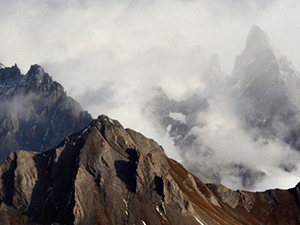NATURAL HAZARDS
PATHWAY 1
NATURAL HAZARDS
PATHWAY 1
Implementation of an Alpine-wide risk management plan, focusing on cross-border risks

Basic information:
The Alps are specifically prone to natural hazards. A generally growing population and accumulation of human assets and settlements in hazard-prone areas as well as extreme events tend to increase natural hazard risk (RSA7).
The Alps face a variety of natural hazards with different scopes including local events such as avalanches, rockfalls, torrential hazards and landslides as well as larger events like floods. As natural hazards do not stop at regional or national borders, an Alpine-wide common framework to deal with such cross-border risks needs to be developed which also enables an exchange of experiences. Basically, risk management for cross-border risks involves the following three questions: 1) What are the potential cross-border hazard hot spots? 2) What risk are we willing to take? 3) Which measures should we adopt? (RSA7).
An Alpine-wide risk management plan on cross-border risks develops a common approach, especially regarding the methods of risk mapping and monitoring for cross-border risks, harmonisation of approaches to deal with residual risks and a common toolbox on measures (including innovative technologies). This Alpine-wide risk management plan should clearly focus on risks with large-scale and potential cross-border impacts, but should also enable an exchange on managing risks on the local scale.
Sequence of implementation steps:
- Information on relevant natural hazards and elements of the risk cycle which are covered in the risk management plans.
- Specific approaches to deal with cross-border risks in national management plans
- Shortcomings and best practices of national plans regarding management of cross-border risks (e.g., regarding early warning systems)
- Consideration of innovative technologies in national plans, especially regarding coordination
- Recommendations and lessons learned
Transport, energy and communication infrastructures build the backbone of the economy, especially for the Alps as crossroads for the European market and as important element of the European energy system. Also, health infrastructures have a cross-border function in the Alps. Specific risks/hot spots for these critical infrastructures need to be identified in a common approach to develop coordinated adaptation solutions.
Furthermore, „hot spots“ for action can arise in settlement areas which are affected by cross-border natural risks. Such hot spots need to be identified in order to develop coordinated approaches for risk management.
- Definition of common steps/cycle of risk management
- Definition of common methods and standards for risk mapping and monitoring, based on existing national legal framework conditions.
- Delimitation of risks that should be considered in the common framework (local vs. cross-border impacts) (based on steps 1a and 1b)
- Recommendations and toolbox on risk prevention measures for cross-border risks (e.g., regarding harmonization of early warning systems, regarding construction stops in flood-prone areas) and experiences.
- Definition of specific measures to deal with hazard “hot-spots” for critical infrastructures and settlements
- Recommendations for practitioners (could also include training/exchange)
Coordination of early warning systems as implemented at national level: harmonization of approach and tools of warning systems.
Establishing interlinkages of warning systems, also with larger warning systems implemented at EU/int. level e.g., EUMetNet, Meteo-Alarm…) to improve the management of cross-border risks
Testing smart approaches of spreading information of early warning systems (Apps for smart phones/smart watches, etc.)
- Identify financing opportunities for structural protection measures, where justified from a cost-benefit perspective
- permanent monitoring of hazard ‘hot spots’
- preparing recovery measures if damages occur
- taking a risk governance approach that seeks to strike a balance between risk prevention goals (adequate protection levels) and risk tolerance (acceptable risk levels), against the background of (public) costs-benefit considerations
Further Information:
- PLANALP working group and EUSALP AG8
- Decision makers at national and regional level
- Decision makers at EU level and providers of meteorological data
- Alpine-wide risk management plan
- Overview on natural hazard management: number of Alpine countries which submitted information regarding their hazard management approaches
- Common framework: number of Alpine countries that have implemented the common approach on risk management.
- Natural hazard “hot-spots”: number of hot-spots that are included in the coordinated approach
- Alpine risk management plan adopted (yes/no)
- Existing risk management systems implemented in the Alpine countries (e.g., Integrated Risk Management approach in CH, Risk mapping approaches in Germany regarding flood risk, transboundary flood risk management plans, etc.)
- PLANALP activities, e.g., Alpine strategy for adaptation to climate change in the field of natural hazards (2013, PLANALP) (stock-taking No. 3), Recommendations on local adaptation to Climate Change for Water Management and Natural Hazards in the Alps (stock-taking No. 8), RSA 7 (stock-taking No. 28)
- EUSALP AG8 activities
- CAPA – Climate Adaptation Platform for the Alps (stock-taking No. 45)
- Network of national adaptation policy makers of the Alpine countries (stock-taking No. 46)
- Adapt-Alp (stock-taking No. 65)
- Virtual Alpine Observatory VAO (DE, since 2014) (stock-taking No. 39)

